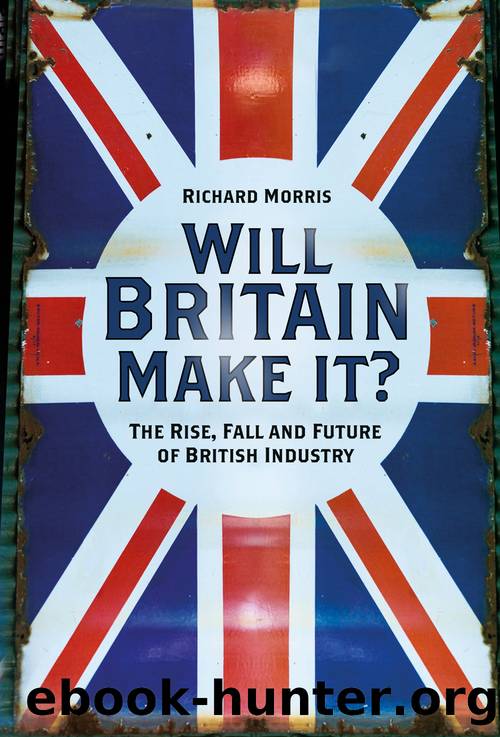Will Britain Make it?: the Rise, Fall and Future of British Industry by Richard Morris

Author:Richard Morris
Language: eng
Format: epub
Publisher: The History Press
10
Imperial Chemical Industries
Imperial Chemical Industries, better known as ICI, would, from its conception, be a firm fixture within the top British companies in the Financial Times Share indices and would for many years be the largest manufacturing company in Britain and Britainâs biggest exporter.
Prior to 1926, Britain had chemical expertise in a number of small companies that specialised in fertilisers, large-scale and specialised chemicals for industrial and agricultural sectors, polymers and specialist materials, paints and explosives. These companies included the Brunner Mond Company, which started in 1873 and specialised in soda ash, soap, fat and TNT. In 1888, Ludwig Mond, surprised that nickel valves he manufactured were being attacked by carbon dioxide in the manufacturing process, discovered that nickel and carbon monoxide reacted to form nickel powder. It stood against chemical convention by showing that a metal could behave as a gas, and led to a cheap method for producing nickel â a key component of the newly emerging âstainlessâ steel. The United Alkali Company was formed in 1890 from the merger of forty-eight small chemical companies based largely across the northern part of Britain. The consolidated company also specialised in soda ash production for the glass, textile, soap and paper industries. British Dyestuffs Corporation Ltd formed in 1919 from the merger of British Dyes Ltd and Levinstein Ltd, producing, as the name suggests, a range of dyes. Nobel Explosives began life in 1870 when Scottish industrialists found the £24,000 needed to set up a factory to exploit the invention of dynamite by Swedish innovator Alfred Nobel. The company would amalgamate with Kynoch, Nobel Industries and Eley Brothers to produce gelignite, guncotton and cordite, and employ 13,000 people.
Even though these companies were large and represented an increasingly consolidated group of British chemical companies, the fragmented nature of the industry still made it difficult to compete against even larger overseas concerns, which included the American DuPont and German IG Farben. British dye companies, for example, had grown since the discovery of the synthetic dye mauveine by the scientist William Perkins in 1856 but were surpassed from 1875 onwards by the German dye industry. The German companies formed dye cartels with both economic and resource advantages over the small, independent British producers, invested more in research and development and provided better technical support to clients at a point where most British companies simply mailed out information circulars. In 1926 therefore, these four leading British chemical companies merged to form one large company known as Imperial Chemical Industries (ICI) with a deal struck aboard the Aquitania during a transatlantic voyage. The Brunner Mond Soda Ash business, for example, would become ICIâs Soda Ash Products (Group), and grow through mergers and acquisitions, and several name changes, to become one of the companyâs most successful divisions and a global leader. The Nobel Explosives company would continue as ICI Nobel and its roundel emblem of a blue circle containing wavy white lines provided ICI with its iconic logo.
ICI would hence, from its start, be a large
Download
This site does not store any files on its server. We only index and link to content provided by other sites. Please contact the content providers to delete copyright contents if any and email us, we'll remove relevant links or contents immediately.
Harry Potter and the Goblet Of Fire by J.K. Rowling(3046)
Never by Ken Follett(2880)
Shadow of Night by Deborah Harkness(2718)
Ogilvy on Advertising by David Ogilvy(2682)
Zero to IPO: Over $1 Trillion of Actionable Advice from the World's Most Successful Entrepreneurs by Frederic Kerrest(2395)
The Man Who Died Twice by Richard Osman(2300)
Machine Learning at Scale with H2O by Gregory Keys | David Whiting(2291)
Book of Life by Deborah Harkness(2263)
How Proust Can Change Your Life by Alain De Botton(2261)
My Brilliant Friend by Elena Ferrante(2223)
0041152001443424520 .pdf by Unknown(2220)
The Tipping Point by Malcolm Gladwell(2204)
How to Pay Zero Taxes, 2018 by Jeff A. Schnepper(2100)
Will by Will Smith(2042)
Purple Hibiscus by Chimamanda Ngozi Adichie(1981)
Hooked: A Dark, Contemporary Romance (Never After Series) by Emily McIntire(1959)
Borders by unknow(1785)
Rationality by Steven Pinker(1765)
Daughter of Smoke and Bone by Laini Taylor(1744)
